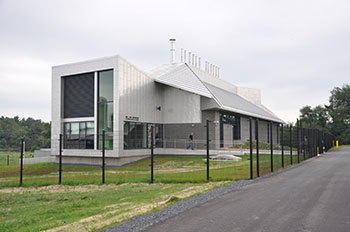AIA New England Recognizes Penn State Lab
 UNIVERSITY PARK, Pa. — Penn State’s Eva J. Pell Laboratory for Advanced Biological Studies (Pell Lab), designed by Payette of Boston, has received the Honor Award for Design Excellence from the New England chapter of the American Institute of Architects (AIA). The award is the highest honor for projects designed by New England firms.
UNIVERSITY PARK, Pa. — Penn State’s Eva J. Pell Laboratory for Advanced Biological Studies (Pell Lab), designed by Payette of Boston, has received the Honor Award for Design Excellence from the New England chapter of the American Institute of Architects (AIA). The award is the highest honor for projects designed by New England firms.
The 22,395-square-foot, bio-containment structure is one of several freestanding research buildings located on the school’s campus. However, the Pell Lab breaks from standard research facility design by diminishing the lines between the building’s interior and the surrounding natural environment.
Providing transparency, light and a connection to the Pennsylvania landscape were critical to the project, according to Payette. Though many similar secured facilities are specifically designed without windows, the $23 million Pell Lab takes great care to provide workers with access and exposure to the outdoors. As such, the twin-concrete block building offers views of the surrounding green space at each end. In its final assessment, an NIH review team stated that the building the most pleasant bio-containment working environment they had ever seen.
The facility, which was completed in 2013, consists of a bio-containment zone and a head house. The concrete, block-clad bio-containment zone houses both animal holding areas and procedure room suites, a secure loading dock and high-level research labs. According to Payette, the research floor is sandwiched between two interstitial mechanical floors that provide access to maintain and service equipment without violating bio-containment barriers.
Meanwhile, the head house is home to several areas including the manager’s office, a conference room, break room, communicating stair between the mechanical rooms and Biosafety Level 3 research lab. The zinc-wrapped head house is also the point at which the dynamic shape of the roof transforms to define the main entrance. According to the university, the angular lab’s undulating roof, which houses a complex array of mechanical systems, is also its most distinctive feature.
Inside, research spaces have been organized into a suite formation, allowing for multiple research projects to be conducted congruently without concerns of cross-contamination. The suite configuration and interior finishes also help facilitate continuous operation of the adjacent research spaces while minimizing research interruption.
Today, the Pell Lab hosts some of the most cutting-edge immunology and infectious disease research in the world. Pell Lab scientists and faculty primarily study aerosol and insect transmitted diseases in a safe and secure environment. Designed as a Select Agent facility by the Federal Select Agent Program, the Pell Lab is also cleared to handle advanced research projects involving biological materials and toxins that are potentially threatening to public, animal and plant health.
In addition to the AIA award, the lab was also awarded 2014 Laboratory of the Year High Honors, an honor granted jointly by R&D Magazine, Laboratory Design Newsletter, and the Scientific Equipment and Furniture Association.
The facility’s construction was supported by the National Institute of Health, as part of the American Reinvestment and Recovery Act. It is currently aiming for LEED Gold certification.
Torcon, headquartered in Red Bank, N.J., served as the project’s construction manager. The project team also included MEP and structural designers from Merrick & Company of McMurry, Pa., as well as civil engineers from Sweetland Engineering of State College, Pa.
